
Papilio multicaudata, the two-tailed swallowtail, is a species of the family Papilionidae found in western North America from British Columbia to Central America.
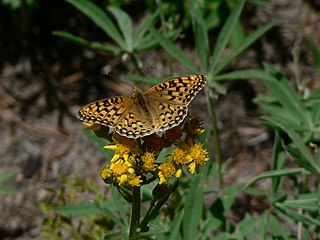
Speyeria zerene, the zerene fritillary, is a butterfly found in the western portions of the United States and Canada. The species was first described by William John Swainson in 1827.

Anthocharis is a holarctic genus of the butterfly tribe Anthocharini, in the family Pieridae. These are typically small, white-hued butterflies that have colorful marks just inside the tips of the forewings. The tip colors are usually a red-orange hue, hence the name "orange tip". The larvae of these butterfly often consume cruciferous plants containing chemicals called glucosinolates. This genus is characterized by two of the five subcostal veins branching off before the apex of the cell, by the upper radial being only little united with the subcostal, and by the central discocellular being rather long. In all the species the males have at least the apical portion of the forewing orange red or yellow. Only one species inhabits also the northern districts of the Palearctic region, all the others are found in the south of the Palearctic region, also some species occur in North America, but not one species extends into the tropics. The Anthocharis species have only one brood. The butterflies occur in spring.
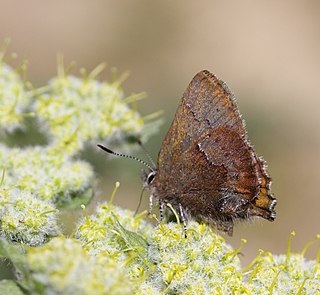
The San Bruno elfin is a U.S. federally listed endangered subspecies that inhabits rocky outcrops and cliffs in coastal scrub on the San Francisco Peninsula. It is endemic to this habitat in California. Its patchy distribution reflects that of its host plant, broadleaf stonecrop.

The genus Callophrys consists of butterflies in the family Lycaenidae. It is apparently not monophyletic, but which of the taxa currently considered junior synonyms of Callophrys are valid genera remains to be determined.
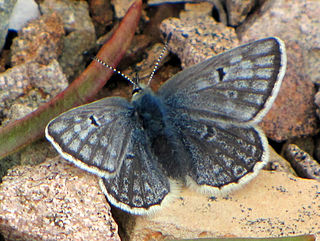
Agriades glandon, the Arctic blue or Glandon blue, is a species of butterfly in the family Lycaenidae. It in found in Eurasia and North America.

Papilio indra, the Indra swallowtail, short-tailed black swallowtail, or cliff swallowtail, is a western North American butterfly in the family Papilionidae.

Polites sabuleti, the sandhill skipper or saltgrass skipper, is a butterfly in the family Hesperiidae. It is found from southern British Columbia and eastern Washington, south through California and northern Arizona to Baja California and east to south-eastern Wyoming, central Colorado, and north-eastern New Mexico. It is an introduced species in Hawaii.

Icaricia saepiolus, the greenish blue, is a butterfly of the family Lycaenidae. It is found from the northwestern United States to southern Saskatchewan and Alberta.
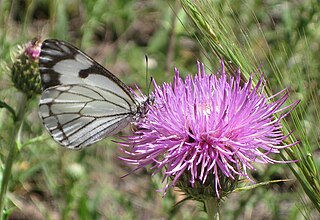
Neophasia menapia, the pine white, is a butterfly in the family Pieridae. It is found in the western United States and in southern British Columbia, Canada.

Ochlodes sylvanoides, the woodland skipper, is a butterfly of the family Hesperiidae. It is found in North America from British Columbia south to southern California, east to Montana, Colorado and Arizona.

Euphilotes battoides, the square-spotted blue or buckwheat blue, is a species of butterfly of the family Lycaenidae.
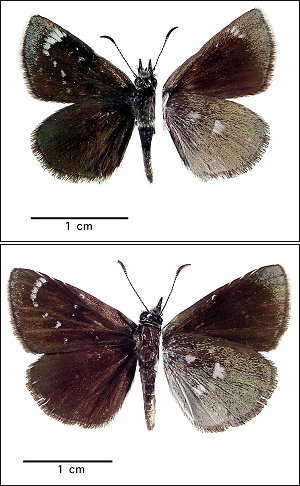
Hesperopsis libya, the Mojave sootywing, Mohave sootywing, Great Basin sootywing or Lena sooty wing, is a butterfly of the family Hesperiidae. It is found in North America from eastern Oregon east to Montana and south to southern California, Arizona, and north-western Mexico including Baja California. Its habitats include alkalai flats, sagebrush desert, desert hills, shale barrens, watercourses, and ravines.
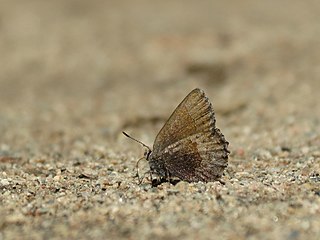
Callophrys polios, the hoary elfin, is a butterfly of the family Lycaenidae. It is listed as a species of special concern and believed extirpated in the US state of Connecticut.

Satyrium saepium, the hedgerow hairstreak, is a butterfly of the family Lycaenidae. It is found in western North America, from British Columbia south through California into Baja California and east through northern Arizona to northern New Mexico, Colorado and Montana.
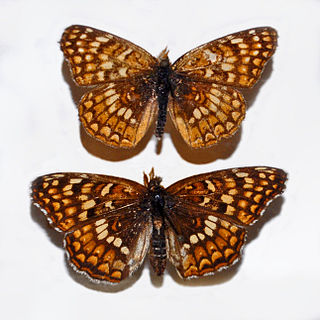
Chlosyne gabbii, or Gabb's checkerspot, is a butterfly from the family Nymphalidae.
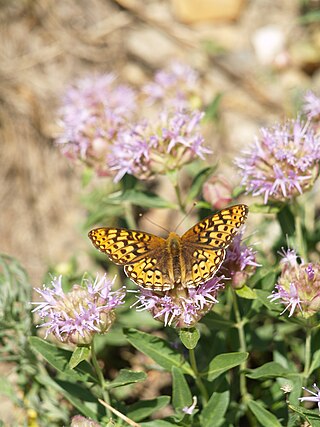
Speyeria egleis, commonly known as the Great Basin fritillary or egleis fritillary, is a butterfly of the family Nymphalidae. It is found in the United States, where it has been recorded from North Dakota southwest through Oregon to California and south to Colorado. The habitat consists of mountain meadows, forest openings and exposed rocky ridges.
Hesperia lindseyi, known generally as Lindsey's skipper, is a species of grass skipper in the butterfly family Hesperiidae. Other common names include the Lindsey's branded skipper and lost-egg skipper. It is found in North America.
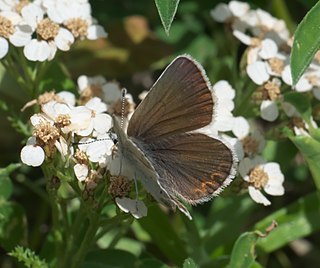
Plebejus anna, or Anna's blue, is a species of blue in the butterfly family Lycaenidae. It is found in North America.

Euphilotes bernardino, the Bernardino blue, is a butterfly in the family Lycaenidae. The species was first described by William Barnes and James Halliday McDunnough in 1916. It is found in North America.



















